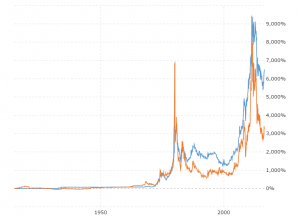The Washington/Carver Commemorative Silver Half Dollar
In 1965 silver coins were no longer legal tender, and people began to horde them, and other silver items. Towards the end of the 1970s the value of silver soared, and many coins were melted down for bullion, and profit. This immediately made surviving coins more valuable as collectibles, and today these coins form the core of many personal collections. There were a number of different silver coins in circulation, and some of the most interesting are coins designed to commemorate important Americans who made the country what it is today.
One of the most interesting is the silver half dollar from the 1950s known as the Washington/Carver half-dollar. This coin was struck between 1951 and 1954, and the exact number still in existence – considering the big ‘silver melts’ – is hard to know. But they are certainly in limited supply, and certified examples will almost certainly increase in value over time. They will remain of interest to collectors in the future.
The designer of the Washington/Carver half dollar was Isaac Scott Hathaway. This sculptor and artist was the first African American to design a U.S. coin. He created two designs for the US Mint. The first, in 1946, was a half dollar with the face of Booker T. Washington, the most prominent African-American of the early 20th century. The Mint’s remaining stock of these coins was ordered to be melted down, and the silver re-struck into the Washington /Carver half-dollar, in 1951.The coins are 90% silver and 10% copper. They weight 12.50 grams, and have a diameter of 30.60 mm.
There were several changes to the original design, but the final model features overlapping profile portraits on the obverse of Booker T. Washington and George Carver. They are surrounded by the words, UNITED STATES OF AMERICA; N GOD WE TRUST; E PLURIBUS UNUM; GEORGE W. CARVER; LIBERTY; BOOKER T. WASHINGTON; HALF DOLLAR, and the relevant strike date. The reverse is a simplified map of America, overlaid with the words, U. S. A. The map is surrounded with the words, FREEDOM AND OPPORTUNITY FOR ALL and, AMERICANISM.
Booker T. Washington founded, in 1881, the Tuskegee Institute, a black college in Alabama. He tried to fight discrimination through education and the creation of black businesses, to build a black middle-class. This approach was later over-turned by the NAACP, which worked for change at a political level.
George Carver was born into slavery, but became a botanist and agricultural scientist, as well as a professor at the Tuskegee Institute. He developed alternative crops to cotton, as the repeated growing of this crop was depleting the soil. He introduced peanuts and sweet potatoes, to enrich the soil and provide direct food for poor Southern farmers. Like Booker T. Washington he believed in advancement through personal improvement and increased wealth, rather than through political action.
The Washington/Carver half dollar was the last commemorative coin struck by the US Mint for several decades, which also makes it a significant collector’s piece. In all the four years it was produced, coins were minted at three facilities – Philadelphia (with no mint mark), San Francisco (S) and Denver (D). When buying these coins, choose certified and correctly grade examples, to be sure they hold their value.








